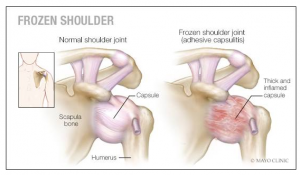More than 200,000 US cases of frozen shoulder are reported every year. This common shoulder dysfunction causes pain and stiffness in the shoulder, limiting one’s ability to perform simple, everyday tasks.

Frozen shoulder, or adhesive capsulitis, occurs when the capsule that surrounds the shoulder joint thickens and becomes inflamed. This most commonly occurs after a shoulder injury or long-term immobility.
According to Mayo Clinic, people with certain diseases like diabetes or Parkinson’s, are also more likely to develop frozen shoulder, though the reason for this is still unknown. Women ages 40-60 are also more at risk than men at the same age.
Symptoms like gradual shoulder pain, limited range of motion and stiffness are all warning signs that should be taken seriously and addressed with a doctor.
How Neuromuscular Therapy and Corrective Exercise Helps
Neuromuscular therapy and corrective exercise is a two-step approach to treating frozen shoulder when prescribed and over the counter pain-relieving or anti-inflammatory drugs are not an option.
Neuromuscular therapy encourages the shoulder muscles to relax by releasing surrounding trigger points that cause pain. NMT techniques involve applying precise pressure to muscle fibers in the shoulder to eliminate tension and spasms. After NMT treatment, corrective exercise helps to stretch and strengthen the shoulder to restore its proper function. These gentle movements challenge the arm’s ability, without causing pain, and helps loosen tightness in the shoulder.
Regular sessions with a licensed neuromuscular therapist and a personalized corrective exercise plan will help to eventually release all of the trigger points firing away in a frozen shoulder.
————————————————————————————————————————–
If you are looking for relief from a frozen shoulder, contact Myopress today to schedule an appointment.
